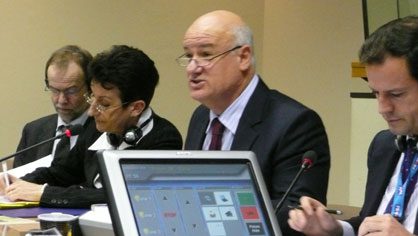5 December 2008
The NFFO used its position on the Advisory Committee for Fisheries and Aquaculture (ACFA) to question European Commissioner, Joe Borg, at a recent meeting in Brussels.
Margin of Tolerance
The Federation raised the issue of the margin of tolerance with the Commissioner. The RACs, national federations and auction authorities have repeatedly stressed that requiring observation of an 8% margin of tolerance between on-board catch estimate and final landing declaration, especially for by-catch species in mixed fisheries, is neither reasonable nor achievable on a consistent basis in the real conditions found aboard fishing vessels. Nothing demonstrates the gulf between the Commission and working fishermen more than the Commission’s repeated denial that this issue presents a problem. Some progress was made in the recently agreed cod recovery plan where the 8% margin is applied only to cod. But incredibly, the recently proposals for a new EC control regulation requires a 5% margin for all fisheries, single species, targeted or by-catch.
The Commissioner made the usual references to past abuse of the 20% MOT, and conspicuously failed to agree to the placement of independent observers aboard a range of fishing vessels in real conditions to see if they can achieve better estimates than our crews. The Commission remains in denial on this subject.
Progress on building a culture of compliance will only be possible if the constant threat of prosecution for failure to meet the unreasonable blanket 8% standard is dealt with. And that will only be when the Commission takes the trouble to investigate for itself whether 8% is achievable or not.
Skates and Rays/Dogfish/ Porbeagle and by-catch species
The inconsistency between the Commission’s public posturing on the discards issue and the practical effect of its TACs and Quota proposals on concrete fisheries – which will be to increase discards -was highlighted by the NFFO. In particular, skates and rays, dogfish, porbeagle, lemon sole and dabs are all fisheries where a decrease in TAC, or restrictive by-catch rules, will lead to an increase in discards rather than a cut in fishing mortality.
The Commissioner agreed to “take another look at the issue before the December Council” whilst emphasising the difficulties of dealing with mixed fisheries, and the survival rates of some species. The Federation stressed the need for an approach that wasn’t dependent on blunt TAC cuts that gave the impression of dealing with the issue but achieve very little in concrete terms.
STECF
The Scientific, Technical Economic and Committee for Fisheries (STECF) may best be described as the Commission’s quality control committee. It provides advice to the Commission on the validity of ICES science and other aspects of fisheries policy and has grown considerably in significance in recent years; it now exerts a strong influence on the content of Commission proposals and therefore fisheries regulations.
The NFFO has in recent years been involved, as observers, in some of the STECF’s work and it is clear that there are some very high calibre people contributing to the Committee’s output. Nevertheless, the operation of STECF is relatively opaque not least in terms of who sets its agenda and how it is decided who sits on it and the balance of biological, economic and practical management expertise within it.
The NFFO told Commissioner Borg that composition of the STECF working groups and how its terms of reference are set and the work of the Committee should be evaluated by external experts (ACFA and the RACs have recently been formally evaluated). STECF could be strengthened by the involvement of practical fisheries managers, economists, and individuals with practical enforcement experience, as well as representatives from the fishing industry.
The Commissioner agreed that “It was not a bad idea, especially in the context of preparations for the reform of the CFP in 2012”. This process will take off properly early next year.
One issue that the Federation has pursued consistently is a fundamental evaluation of the role that effort control is playing within the CFP. It is clear that restrictions on days at sea increases the industry’s costs but it is far from clear whether they have had any direct effect in cutting fishing mortality. This is the kind of fundamental question we think that STECF could usefully tackle. Given the central role that the Commission gives effort control this is a crucial question that should not be ducked.

